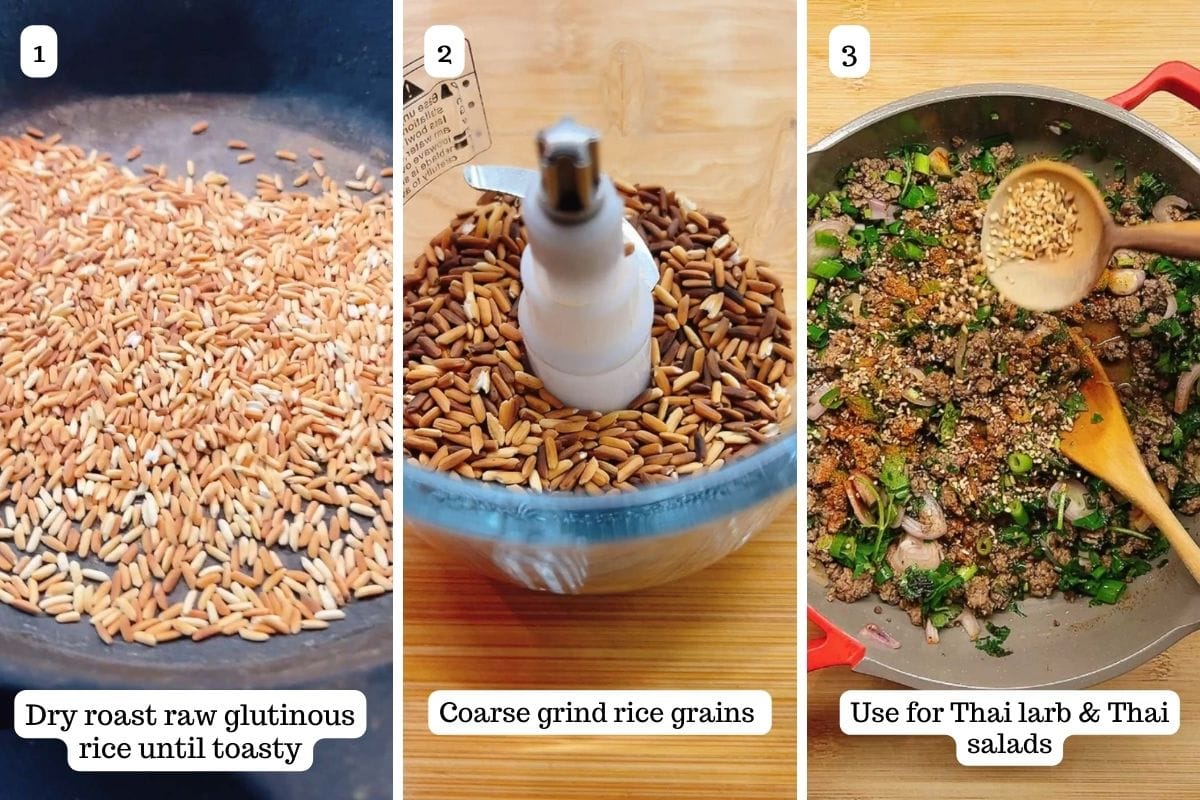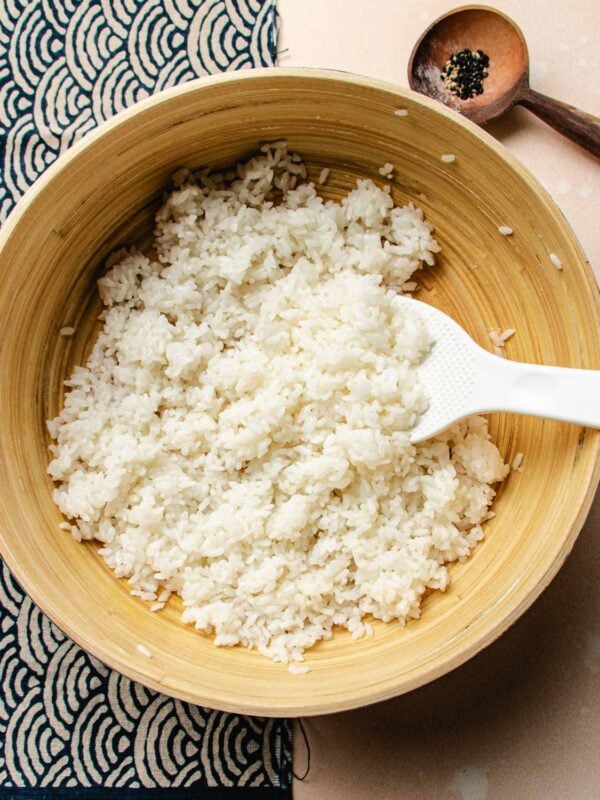This post may contain affiliate links. Please read our disclosure policy.
Toasted rice powder (or Khao Khua / ข้าวคั่ว in Thai) is a versatile condiment used in Thai cuisine as a texture and nutty flavor booster. This authentic Thai pantry staple is made from dry-roasted sticky rice grains ground into a coarse powder.
Khao khua can be used to add a wonderfully crunchy texture and toasted nutty aroma to many dishes. It is a key ingredient in Thai larb, Thai beef salad (Nam tok neua), and Thai mushroom salad and can also be used to thicken sauces and soups.

Table of Contents
What is roasted rice powder used for?
Toasted sticky rice powder, or Khao Khua, is made from glutinous rice grains that are dry roasted and coarsely ground. It adds a crunchy texture and nutty taste to dishes, giving them an authentic Thai touch. It is also called larb powder because it’s strongly associated with the yummy Thai salad.
- Uses: Aside from being a great flavor enhancer, it adds crunch, helps absorb excess moisture from watery dishes, and is a natural thickener for sauces.
- Flavor: The flavor is toasty and nutty, similar to popcorn kernels and crispy rice puffs.
- How to use: Lightly sprinkle 1-2 tablespoons over food, such as Thai pork larb or beef larb, right before serving. Mix it into sauces, like my Thai chili sauce (Nam jim jaew), to thicken.
Ingredients and tools
To make this homemade Thai roasted rice powder, you only need a small amount of uncooked Thai sticky rice grains and a few tools. This recipe makes about ⅓ cup coarsely ground rice powder, but you can make a larger batch and store leftovers for up to a month to use as a tasty condiment.

Save This Recipe
- Sticky rice grains: Also called glutinous rice or sweet rice, dry and uncooked.
Tools:
- Pan: You can use a cast iron skillet, stainless steel pan, or wok.
- Grinder: A spice grinder, coffee grinder, or mortar and pestle work best. You could also try a small food processor or blender.
- Storage: An airtight small food storage container for leftover roasted rice flour.
Toasted rice powder substitute
- Different rice grains: If you don’t have sticky rice (also known as sweet rice or glutinous rice) on hand, you can use short-grain white rice as a substitute due to its higher starch content. Medium grain Jasmine rice is another good option.
- Low-carb and grain-free option: Try using raw cashews or slivered almonds mixed with hemp seeds as a rice powder substitute. Lightly pan roast them without oil for 2-3 minutes over medium-low heat, then coarsely grind them into chunky bits.
How to make toasted rice powder
Khao Khua is so simple to make! It is essentially just toasted ground rice made from uncooked sticky rice grains. Here are some simple tips and tricks for this toasty rice powder recipe.

- Dry roast the rice: Add the uncooked rice grains to a medium pan and slowly dry roast them over medium heat until they turn a deep golden brown color, about 15 minutes.
- Cool and grind rice: Once toasted, set them aside to cool to room temperature then transfer them into a spice or coffee grinder. Pulse a few times to coarsely grind the toasted rice.
- Use and store: Sprinkle over Chicken larb salad, Thai pork larb, Thai beef salad, Thai mushroom salad, and more. Store the extra in an airtight container in a cool and dry place for up to 1 month.
TIP: Use slow and low heat to dry roast the rice grains and shake the pan periodically to ensure even roasting and to release the aroma as the rice becomes toasted.
Do you need to wash toasted rice?
No, you don’t need to wash the rice before making toasted sticky rice powder. Washing the rice grains would add moisture, which can mess up the toasting process and stop the grains from getting that perfect crunchy texture and color.
Instead, focus on buying good-quality glutinous rice grains. I recommend the Three Elephants brand from Thailand, which you can find online here (product link).
Rice powder uses
Wondering what to make with rice powder? The possibilities are endless! Use your homemade roasted glutinous rice flour as a flavorful and crunchy topping or as a natural thickener. Use rice powder for larb, salads, noodles, stir-fries, sauces, soups, and more!
Storage tips
Store roasted ground rice powder in an airtight jar in a cool, dry cupboard for up to one month. While it may last longer, the nutty aroma might fade over time.
What else can you make with sticky rice?
Sticky rice has so many great uses outside of making this powdered rice condiment! Sticky rice is a versatile ingredient that can be enjoyed with sweet or savory dishes. You can even make sticky rice flour!
- A side dish: Cook sticky rice in rice cooker or microwave sticky rice to use as a side dish in place of steamed rice. It’s a fun change in texture and you can use your hands to eat it!
- As a main dish ingredient: Use sticky rice as an ingredient in your main dishes, like this easy Chinese sticky rice with sausage or my delightful sticky rice stuffing.
- As a sweet treat: Perhaps the most well-known use of sticky rice in Asian cuisines is as a dessert, like this classic Thai coconut sticky rice with mango.
Helpful tips
- Correct Rice Grains: Use sticky rice, also labeled as glutinous rice or sweet rice. Regular white rice (sushi rice or jasmine) is not the same. Please read the ingredient label.
- Raw Uncooked Rice: Use dry (unwashed), uncooked rice so that it will toast properly.
- Avoid Burning: Shake the pan periodically to prevent burning and ensure even toasting.
- Grinding: Don’t grind the rice into a fine powder as you would to make toasted rice flour; it should be coarsely ground for the best texture.
- Use Proper Cookware: A cast iron, wok, and stainless steel pan works best as these retain heat more steadily. Avoid non-stick pans, as the high heat might damage them.
- Adjust Heat: Depending on your cookware, adjust the stovetop temperature. Cast iron retains heat better, so it might require less heat over time compared to stainless steel.
FAQs
More Thai recipes you might like
This tasty Thai rice powder condiment can be sprinkled on so many dishes! Here are some of my favorite Thai recipes to make at home. Give them a try!
- Chiang Mai noodles or khao soi gai is a soupy chicken curry from the north of Thailand.
- Pad Woon Sen with stir-fried glass noodles, chicken, shrimp, and vegetables is a classic!
- Thai basil chicken with ground chicken and a sweet and savory sauce is so tasty.
- Thai cashew chicken glazed in a sweet and salty cashew sauce—yum!

Toasted rice powder recipe

Ingredients
- 0.5 cup Glutinous rice grains dry and uncooked
Tools:
- A cast iron skillet stainless steel pan, or wok
- A coffee grinder or mortar and pestle
- An airtight small food storage container
Instructions
- In a medium size cast iron or stainless steel pan, add the rice grains and dry roast them over medium heat until the grains turn into golden brown color, about 15 minutes.
- Shake the pan periodically so that the rice grains aren’t burnt and toasted evenly on all sides. You will smell a nice aroma as the rice becomes toasted.
- Once the rice grains are toasted to golden brown, set them aside to cool to room temperature then transfer them into a spice or coffee grinder and pulse a few times until they are coarsely grind.
- You can use them right away to sprinkle over Thai larb, Thai beef salad, Thai mushroom salad, and more. Store the extra in an airtight container in a cool and dry place for up to 1 month.
Notes
- Toasted rice powder has a crunchy and nutty aroma that’s similar to the flavor of toasted puff rice.
- Take care not to burn the rice grains and avoid grinding them into a fine powder. They should be coarse ground. If you have a mortar and pestle, use that!
- Use a cast iron, wok, or stainless steel pan as they retain heat more steadily.
- Non Stick pan is not ideal for dry roasting as the pan will get quite hot and it might damage your cookware.
- Adjust the stovetop temperature based on the type of cookware that you use. Cast iron and wok retain heat better, so it might require less heat over time compared to stainless steel.
- Uses: Sprinkle on Thai larb, Beef larb, Thai beef salad and more!
Nutrition
Nutrition information is automatically calculated, so should only be used as an approximation.













This was much easier than I thought to make and the rice powder does add crunch and Smokey flavor. Thanks for the instructions.
Thank you!